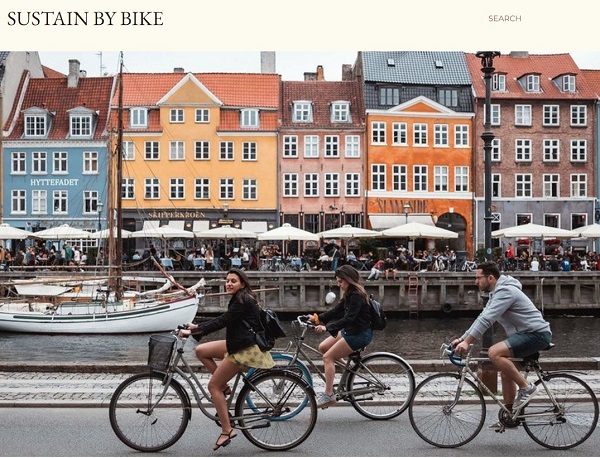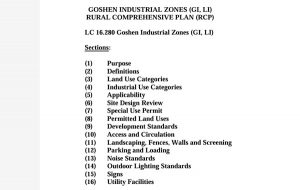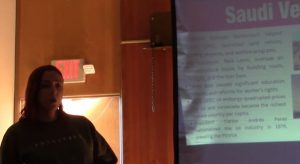Eugene looks at transportation options in Denmark, Netherlands
6 min read
A look at two countries transitioning to a safer transportation system at the Oct. 13 meeting of Eugene’s Active Transportation Committee.
[00:00:09] Claressa Davis: I’m Claressa, I’m a current 3PM student (planning, public policy, and management) at the University of Oregon. This past summer, I had the opportunity to participate in Sustainable Bike Transportation in Europe Study Abroad. We spent two weeks in Denmark and then two weeks in the Netherlands. In total, we traveled to six different cities by bike and public transportation. Within this entire month. I didn’t enter a car once.
[00:00:31] Arriving in Copenhagen was astonishing. I had literally never seen so many bike commuters in my entire life. And it was honestly slightly overwhelming to see so many people out biking.
[00:00:43] Almost always, biking is literally the shortest route to get from one destination to another, and it’s the fastest way to travel. And it was way easier to park. There was bike parking everywhere. Biking in these places, I felt prioritized in a way that I haven’t really ever felt in the States. We never had to compete with cars on the roadway and it never felt like we were jostling for space. This made it feel a lot more relaxed and comfortable.
[00:01:09] Additionally, a city with less traffic, less cars has a lot more space. And additionally, there was huge feelings of safety. It really changed my perception of the city to be able to see bike commuters all day long. It felt like, okay, if I have an issue here, there’s going to be here if someone here who can help me out.
[00:01:24] Every street had a cycle track. These are cycle tracks, so they’re dedicated lanes that are a little bit picked up off the roadway. And you didn’t have to compete for space at all except for maybe with other cyclists, which felt a lot less dangerous than with a car. Additionally, when there was construction, there would always be a way around it… you just knew that the infrastructure was going to be there and it was going to support you.
[00:01:44] And this really made the cities a lot more reliable, feeling that transportation was a lot more reliable. And another way they increased reliability was having really good lighting. They wanted people to be able to use their infrastructure 24 hours a day, 365 days a year.
[00:01:58] They said that their transportation network would only be as good as their weakest link, so they had to bring up that weakest link. And I think that that’s something we can definitely take away here.
[00:02:06] Because of this high level of safety, it actually made cycling way more accessible to youth and elders. Children grew up, like grew up on bikes here, they would ride with their parents and by the time they started learning to bike, they were already really comfortable with it. And that led to a really high level of independence in children.
[00:02:21] When this infrastructure is really safe, safe enough for young people, it was also safe enough for older people.
[00:02:27] So the elevated cycle track this was prevalent in both the Netherlands and Denmark. And in Denmark, almost every single road had a cycle track. They had contraflow cycle track, so you would bike one way and cars would be going on the opposite way. These were about 2.2 meters wide, which is wide enough for cargo bikes to pass each other. So you definitely had a lot of space, which was really—and they had little curb mounts that were really easy to hop on and off wherever you felt like, wherever planners and designers thought that people would want to hop on and off.
[00:02:57] Also intersections: Intersections can be kind of intimidating as a cyclist and they really worked to slow them down and make you feel like you are safe in them. One of the ways they’ve done that is by pulling out the bike stop lane way in front of the cars. That way when cars are stopped on a red light, they can easily see bicyclists.
[00:03:16] Bikes also have their own dedicated signal and they get a green first, so they get way out of that blind spot. They then get a red first, which will allow cars to complete any turns that they need to do.
[00:03:26] The Netherlands has reached this critical point in cycling where so many people cycle that their off-street or like their cycle tracks are no longer big enough to accommodate their cyclists, which is amazing and phenomenal and not necessarily where we are at. So it’s harder to talk about and compare for us because they’ve taken roads and like full roads and turned them into fietsstraats, which is like an entire road dedicated to bikes. Cars can go down it, but they’re expect to go really slowly and navigate out of the way of cyclists.
[00:04:04] In all honesty, it wasn’t about the bikes, it was about the enhanced quality of life that we experienced and that the people in these societies experienced there. They had freedom in time and destination. It’s about easy transportation, clean air, safe streets, improved mobility for youth and others, and a better quality of life.
[00:04:24] Sue Wolling: I hadn’t realized that apparently in the Netherlands they had very much a car culture as ours up through about the 1970s, which is not that long ago, and they have made a total transformation and they’re not as wealthy a country as we are. And they have totally turned things around in just a few decades. And so it was impressive to hear that fact and then to see how quickly they made all these changes.
[00:04:49] Julie Daniel: We tend to try to do things almost perfectly, and do very few of them rather than just put in some plastic things and bolt them to the street and just make it so much, much cheaper and much quicker and make a lot of change really quickly. I think sometimes we just try to overthink it and just do the perfect thing rather than a good thing.
[00:05:12] What if we took one neighborhood and made it absolutely wonderfully bike-friendly so that all the other neighborhoods went, ‘How come they get it?’ And then, you get a much greater push if you make one neighborhood show: This is what it could be like, this is what it would be like if every neighborhood street, every street in this neighborhood had bumpouts.
[00:05:33] Andrew Martin: We have a lot of, like, rules, like the MUTCD (Manual of Uniform Traffic Control Devices) and engineers in the United States have a lot more liability and so they’re not as willing to get away from these standards books. And so I think one of the big differences that I heard was just their engineering philosophies. They have a manual, it’s called the Crow Manual, but you don’t have to follow it. It’s like a light suggestion.
[00:05:57] Claressa Davis: They did a lot of pilot projects and then data studies. So they do data studies before an intersection. They would test out with a small pilot project that could go in for a year and then come out and then they would run tests at the end of it to see, okay, ‘How are people using this intersection now?’ And if it went well, they could scale that out into different parts of the neighborhood. And so sometimes they tried and they took them out. They were like, ‘That did not work at all.’ But then they were able to learn and build something that did work.
[00:06:21] John Q: They also had a faster process for public engagement.
[00:06:25] Claressa Davis: We were talking about, ‘So how do you get this all passed so quickly? Like, how do you have like these stakeholder meetings?’ And she said, ‘Oh, well, we’ll make a design. We’ll go talk to the neighborhood that it’s going directly in, we’ll hear what they have to say. We might change our design and then we’ll put it in.’ So it was way less involved than what we have and that really streamlined their process and allowed them to pursue what they feel the city needs. There are benefits and not negatives to that. But it was definitely a lot faster of a process.
[00:06:54] John Q: The committee hopes to bring lessons from Denmark and the Netherlands to the streets of Eugene.



